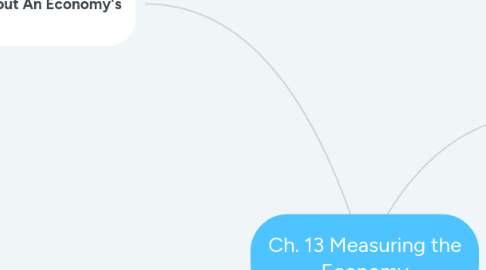
1. 13.4 What Does The Inflation Rate Reveal About An Economy's Health?
1.1. inflation rate: the percentage increase in the average price level of goods and services from one month or year to the next
1.2. Tracking Inflation with consumer price index is a key way to reveal an economy's health, BLS tracks inflation by taking in information on Americans' cost of living.
1.3. price index: a measure of the average change in price of a type of good over time
1.4. consumer price index: (CPI)a measure of price changes in consumer goods and services over time; the CPI shows changes in the cost of living from year to year
1.5. cost-of-living index: a measure of change in the overall cost of goods and services; another term for the consumer price index
1.6. When adjusting for inflation Nominal vs the Real Cost of Living is used
1.7. In an ideal world prices would be stable however in the real world we are constantly dealing with creeping inflation, hyperinflation, or deflation
1.8. Economic costs of inflation include, loss of purchasing power, higher interest rates, and loss of economic efficiency
2. 13.5 How Does The Business Cycle Relate To Economic Health?
2.1. The 4 phases of a Business Cycle include a period of growth and a period of decline, as well as the turning points that mark the shift from one period to the next
2.2. business cycle: a recurring pattern of growth and decline in economic activity over time.
2.3. Irregularities in length and severity are common in Business cycles making peaks and troughs difficult to predict
2.4. Business cycles are commonly known as periods of booms and bust, these contribute to the health of an economy overall
2.4.1. boom: the expansion phase of the cycle, recovery, upturn, upswing, or period of prosperity. The Economy is healthy and growing
2.4.2. bust: contract-ion phase of the business cycle, is also called a downturn, a downswing, or a recession.
2.5. Economic indicators are important ways to determine the expansions and contractions of an economy. Indicators include Leading indicators, Coincident indicators, Lagging indicators.
2.5.1. Leading indicators: Measures that consistently rise or fall several months before an expansion or a contraction begin
2.5.2. Coincident economic indicators: measures that consistently rise or fall along with expansions or contractions
2.5.3. Lagging indicators: Measures consistently rise or fall several months after an expansion or a contraction
3. 13.2 How Do Economists Measure The Size Of An Economy?
3.1. One of the main ways economists measure the size of the economy is by GDP
3.2. GDP: the market value of all final goods and services produced within a country during a given period of time]
3.3. Economists calculate GDP by using the following formula C + I + G + NX = GDP
3.4. Economists use Nominal GDP when adjusting for inflation.
3.5. Economists use Per Capita GDP when adjusting for population
3.6. GDP makes people better off in the following ways: Literacy and Education, Health and Life Expectancy, and the standard of living
3.6.1. literacy rate: the percentage of people in a country who can read and write]
3.6.2. life expectancy: the number of years, on average, that a person is expected to live; a key indicator of a nation’s health and well-being]

